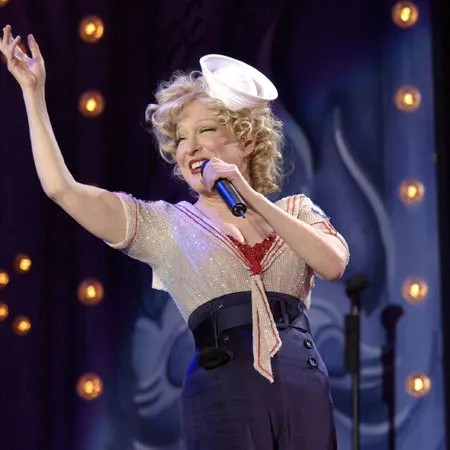“𝘽𝙤𝙤𝙜𝙞𝙚 𝙒𝙤𝙤𝙜𝙞𝙚 𝘽𝙪𝙜𝙡𝙚 𝘽𝙤𝙮” – 𝘽𝙚𝙩𝙩𝙚 𝙈𝙞𝙙𝙡𝙚𝙧

“Boogie Woogie Bugle Boy” by Bette Midler: A Nostalgic Tribute to Swing and Sisterhood
Released in 1972 as part of her debut album, “The Divine Miss M,” Bette Midler’s rendition of “Boogie Woogie Bugle Boy” became a standout hit. Originally popularized by the Andrews Sisters in the 1940s, Midler’s version revitalized the classic swing song with her own unique style and vocal prowess. Known for her charismatic stage presence and versatility, Midler’s interpretation of “Boogie Woogie Bugle Boy” remains a beloved homage to the swing era.
Bette Midler is an iconic American singer, actress, and comedian known for her powerhouse vocals, theatrical performances, and eclectic repertoire. Throughout her career, Midler has achieved critical acclaim and commercial success across various genres, from pop and rock to Broadway and film.
The Song: “Boogie Woogie Bugle Boy”
“Boogie Woogie Bugle Boy” is characterized by its infectious rhythm, upbeat tempo, and catchy melody. The song’s lyrics tell the story of a trumpet player in the military who becomes famous for his boogie-woogie style, accompanied by the harmonious backing vocals of the Andrews Sisters.
Key Elements and Structure
- Vocals: Bette Midler’s rendition of “Boogie Woogie Bugle Boy” showcases her dynamic vocal range and playful delivery. Her performance captures the song’s exuberant spirit while adding her own flair and interpretation.
- Instrumentation: The song features a lively arrangement with swing-era elements, including horns, percussion, and a driving bass line. The instrumental backing complements Midler’s vocals and enhances the song’s nostalgic appeal.
- Lyrics and Theme: The lyrics of “Boogie Woogie Bugle Boy” celebrate the joy of music and the camaraderie among musicians. The song’s narrative highlights the trumpet player’s journey from obscurity to fame, thanks to his distinctive musical style and the support of his fellow band members.
- Musical Impact: Midler’s rendition of “Boogie Woogie Bugle Boy” revitalized interest in the classic swing song, introducing it to a new generation of listeners. Her energetic performance and homage to the Andrews Sisters’ vocal harmonies pay tribute to the golden era of big band and swing music.

Chart Success and Legacy
Midler’s version of “Boogie Woogie Bugle Boy” achieved commercial success, reaching No. 8 on the Billboard Hot 100 chart in 1973. The song’s popularity was driven by its catchy melody, lively arrangement, and Midler’s charismatic interpretation.
The track’s legacy continues to endure, with “Boogie Woogie Bugle Boy” remaining a beloved classic and a staple in Midler’s live performances. Its nostalgic charm and infectious energy have cemented its status as one of the standout hits of her career.
Conclusion
“Boogie Woogie Bugle Boy” by Bette Midler is more than just a cover song; it is a vibrant tribute to the swing era and the enduring legacy of the Andrews Sisters. With its infectious rhythm, playful lyrics, and Midler’s dynamic vocals, the song captures the exuberance and camaraderie of musicians during wartime. Whether you’re a longtime fan of swing music or discovering Midler’s rendition for the first time, “Boogie Woogie Bugle Boy” offers a lively and nostalgic musical experience that continues to entertain and delight audiences around the world.
Video:











